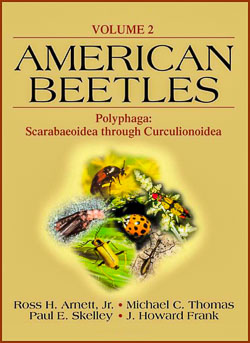American Beetles

Publisher:
CRC Press 1st edition (December 28, 2000)
Language: English
Paperback: 464 pages
ISBN-10: 0849319250
ISBN-13: 978-0849319259
Item Weight: 2.35 pounds
Dimensions: 8.5 x 1.06 x 11 inches
American Beetles Volume 1
A thorough update of Arnett's The Beetles of the United States, American Beetles, Volumes I and II cover the genera of beetles that occur in Alaska, Canada, and the contiguous United States. Built on the foundation of the original work and almost completely rewritten with contributions from more than 60 coleopterists, these volumes describe each family with separate paragraphs for head, thorax, abdomen, genitalia, eggs, larvae, and pupae. This bestselling first volume covers the suborders Archostemata, Myxophaga, and Adephaga, plus the series Staphyliniformia of the suborder Polyphaga.
Arnett and Thomas offer the most sweeping text available on the subject of North American beetles. Each section is presented in the same concise format, and the organization of the information is bt family. The editors have chosen the most respected of specialists to contribute the entries.

Publisher:
CRC Press 1st edition (July 27, 2017)
Language: English
Hardcover: 861 pages
ISBN-10: 113842370X
ISBN-13: 978-1138423701
Item Weight: 1 pounds
Dimensions: 8.5 x 2 x 11 inches
American Beetles Volume 2
It has been nearly 40 years since Ross H. Arnett, Jr. published the first fascicle of The Beetles of the United States: A Manual forIdentification. It quickly became an indispensable tool for professional and amateur coleopterists, general entomologists, and natural-ists. Although there were four additional printings it has long been out of print and difficult to obtain. It was prepared to replaceBradleyís A Manual of the Genera of Beetles of America, North of Mexico, which itself was some 30 years out of date in 1960. AmericanBeetles is, in turn, designed to replace The Beetles of the United States. It is hoped that it will prove to be as useful as its predecessor.Ironically, much of the preface to the original edition applies today as well as it did 40 years ago:Many genera have since been described and reported within the area concerned, and many families have beenrevised. Extensive changes have been made in the family classification of the beetles of the United States during thisperiod.The aim of this series of fascicles is to provide a tool for the identification of adult beetles of the United Statesto family and genus with the aid of illustrations, keys, descriptions, and references to sources for keys and descrip-tions of the species of this area. All of the genera known to inhabit this area are included in the keys and lists ofgenera which follow.The design and format of this work follow closely that of the original edition, but the way it was put together was quite different.Its predecessor was very much the work of one man, Ross H. Arnett, Jr. With a few exceptions (George Ball wrote the carabid treatmentfor both the 1960 edition and for this one), Dr. Arnett wrote the family treatments of The Beetles of the United States. Many specialistsreviewed those chapters, but they were almost entirely Dr. Arnettís work.When Dr. Arnett announced plans to prepare a work to replace The Beetles of the United States, coleopterists literally lined up tovolunteer their time and expertise in preparing the family treatments. Ultimately, more than 60 coleopterists participated in thepreparation of American Beetles. This has truly been a community project.Due to the size of the ensuing work, American Beetles is being printed in two volumes. Volume 1 includes the introductorymaterial, and family treatments for the Archostemata, Myxophaga, Adephaga, and Polyphaga: Staphyliniformia. The remainder of thePolyphaga and the keys to families appear here in Volume 2.Sadly, although Dr. Arnett initiated this project and was instrumental in its planning, he did not live to see its fruition. He becameseriously ill in late 1998 and died on July 16, 1999 at the age of 80. We hope he would be pleased with the outcome.Michael C. Thomas, Ph.D.Gainesville, FloridaApril 3, 2002